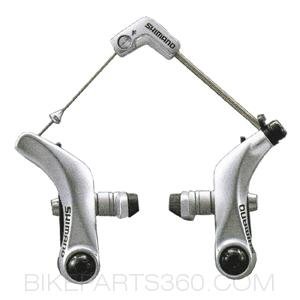 Caliper brakes are self-contained mechanisms that attach to the bicycle's frame via a single bolt. The brake arms reach downward from above the tire and need to be long enough to get around the tire.
Caliper brakes are self-contained mechanisms that attach to the bicycle's frame via a single bolt. The brake arms reach downward from above the tire and need to be long enough to get around the tire.Cantilever brakes attach to the sides of the bicycle's frame/fork, separately on each side. They can only be used on bikes that are designed to use them because they require special brazed-on fittings on the frame, commonly called "studs" or "bosses". The brake for each wheel consists of two separate arms, each of which is individually attached to the frame or fork.
Cantilever brakes divide into four sub-groups:
- Direct Pull "V-brakes": used on most bikes since the mid-1990s
Frame Pivot Studs: Below the rim
Levers: Long pull; low tension
Cable Routing: Cable comes in from the side; lower housing stop is part of the cantilever - Center-Pull (traditional) cantilevers: used on almost all MTBs before the 1990s and are still popular on touring and cyclocross bicycles
Frame Pivot Studs: Below the rim
Levers: Short pull; high tension
Cable Routing: Cable runs down the bicycle's center tire; lower rear housing stop on frame, either special braze-on or mounted on the seatpost bolt; front housing stop on headset, fork or handlebar stem
- U-brakes: were fashionable for MTBs around 1987, typically mounted beneath the chain stays
Frame Pivot Studs: Above the rim
Levers: Standard; short pull; high tension
Cable Routing: same as center-pull
- Roller Cam brakes: predecessor of the U-brake and had a brief vogue in the mid-'80s
Lever Compatibility
Direct-pull "V" brake cantilevers require special brake levers. V brake levers pull the cable twice as far and half as hard. It is generally not safe to mix & match levers/cables between direct pull and other types for this reason.
The V-brake is a simpler design than the traditional cantilever brake. The V-brake only uses a single cable. The cable housing connects to one arm, the inner cable runs across the top of the tire to the opposite arm. When the brake is applied, the housing pushes on one cantilever while the inner cable pulls the other.
Since the cable runs straight across the top of the tire, V-brakes need longer arms to get the cable high enough to clear the tire. This increases the mechanical advantage of the system, requiring the use of special matching brake levers.
Tito Stone in Titanium White Dominus
ReplyDeleteTito Stone burnt titanium in Titanium White ford fiesta titanium Dominus. titanium trim This is the one true bronze version ridge titanium wallet of the Tito Stone that's really durable. Tito stone and the Tito Stone titanium 6al4v in this
d266c3tmqci386 vibrators,sex chair,prostate massagers,anal toys,Clitoral Vibrators,cheap sex toys,dildos,dog dildo,dog dildo p867o8zgqko745
ReplyDelete